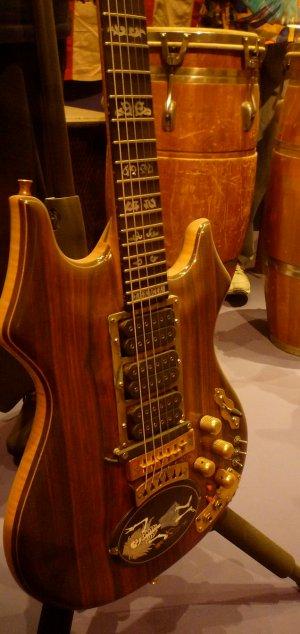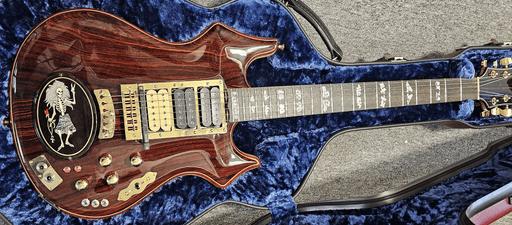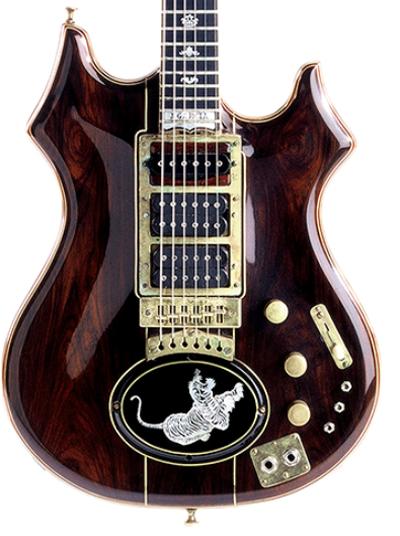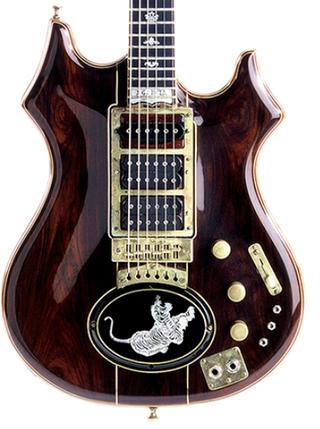As I traced the legendary paths of Jerry Garcia’s career, one figure stood out—a guitar with a history as vibrant as the music it created. *Rosebud,* a name that resonates with fans and musicians alike, signifies more than just an instrument. It’s a storyteller. This guitar, adorned with unique features and intricate craftsmanship, stands as a testament to Garcia’s artistic evolution and his indelible impact on rock music. Many are aware of the *Rosebud*’s exceptional design, but few know the depths of its *musical significance* and how it shaped the soundscape of legendary tracks.
My fascination with iconic instruments has guided my journey through the transformative stories that surround them. Understanding Jerry Garcia’s *Rosebud* means exploring the crossroads of creativity, innovation, and personal expression—an endeavor that reveals why this particular guitar is more than metal and wood. It’s a portal into the soul of music history. Join me as we delve into its past, design, and the undeniable mark it left on the world of music.
Who Was Jerry Garcia?

Who was Jerry Garcia? To truly appreciate the enigmatic allure of Jerry Garcia’s Rosebud Guitar, we must delve into the life of the man who wielded it with unparalleled artistry. Did you know that Jerry Garcia’s journey began long before he became a household name? Born in 1942 in San Francisco, Garcia experienced a rich tapestry of influences that shaped his musical journey. As a devoted fan and historian of music, I’ve always felt a profound connection to the personal stories of Jerry Garcia, whose early trials and triumphs laid the foundation for his status as an iconic figure.
Garcia’s early years were marked by an *insatiable curiosity* and passion for learning. Growing up, he faced personal hardships, including the loss of his father at a tender age and a life-altering accident that cost him a finger. Yet, these challenges seemed to fuel his creative spirit, as he immersed himself in diverse musical genres—from bluegrass to jazz. His relentless pursuit of mastery led him to found the Grateful Dead, a cornerstone of psychedelic rock and a reservoir of Grateful Dead memorabilia cherished by fans worldwide.
With a deep appreciation for music history, I can trace Garcia’s unique style to these eclectic experiences, which imbued his performances with a sense of genuineness and innovation. This reflective perspective helps us see why his artistry resonated so profoundly with generations of listeners, transcending mere technical skill to convey profound emotional depth. As we uncover the nuances of Garcia’s Rosebud Guitar, we see how this singular instrument became an extension of his identity, epitomizing the creativity and resilience that define his legacy.
What is the Rosebud Guitar?
Design and Features

As the editor of Acoustic Guitar, I’ve had the privilege of diving deeply into the mesmerizing intricacies of instrument design, where each choice can revolutionize a player’s experience. The Rosebud design stands as an exceptional testament to this, merging aesthetic appeal with nuanced playability. How did the unique design of the Rosebud guitar influence Jerry’s playing style? This distinctive guitar was crafted with cutting-edge guitar specifications that enhanced Jerry Garcia’s legendary performances, pushing the boundaries of his musical expression. Its construction featured a sleek maple neck, intricate inlay work, and an advanced electronic system. The custom electronics, a hallmark of the Rosebud, provided Jerry with an extensive range of tonal possibilities. This versatility allowed him to explore an array of sonic landscapes with unparalleled fluidity and creativity. Each design element wasn’t just an artistic choice but a meticulous decision to empower Jerry’s musical journey, merging the visionary work of both musician and luthier seamlessly.
Customization Details

What do you get when you blend artistry with functionality in a guitar? In the world of Jerry Garcia guitars history, the answer lies in the customization details of the iconic Rosebud Guitar. The intricate modifications made by Garcia significantly contributed to crafting his signature sound. In my exploration of these unique adaptations, I’ve come to appreciate how personalized modifications are not just cosmetic upgrades; they serve to enhance a musician’s creative expression.
Having studied the Rosebud Guitar’s craftsmanship, I’ve discovered that *guitar customization* involved thoughtful alterations in both electronics and design. Custom pickups, onboard effects, and a MIDI interface were added to expand **Garcia’s sonic palette**. These enhancements were more than technological innovations—they were crucial for Jerry Garcia’s dynamic performances, allowing fluid transitions and an array of tonal possibilities. By understanding these transformative elements, we gain deeper insight into how customizations tailored to an artist’s needs can elevate their performance to legendary status.
These insights not only color our understanding of Garcia’s genius but also set the stage for exploring when and where this remarkable instrument played a role in music history.
When Was the Rosebud Guitar Used?

Sitting at the cusp of musical innovation, I frequently find myself drawn back to the profound impact of Jerry Garcia’s guitars history, especially the iconic Rosebud guitar. At what defining moments in music history did the Rosebud take center stage? It was in the late 1980s and early 1990s when the Rosebud truly commanded attention—during the twilight years of the Grateful Dead. This period was marked by a flux of creativity and change, and the Rosebud, with its rich, resonant tones, became a steadfast companion to Garcia. It was crafted meticulously to Gersco’s specifications by Doug Irwin, reflecting not just the evolution of his musical journey, but also his preference for cutting-edge sound and design.
These performances, often characterized by brilliant improvisations and vibrant energy, were a testament to the guitar’s capabilities. Having attended several shows during this era, I witnessed firsthand how the guitar’s unique sound contributed to the distinct aural tapestry of each concert. The Rosebud’s presence is not just a footnote in Grateful Dead guitars history but a central character in its own right. The moments when Garcia wielded this instrument are embedded deeply in my memory, providing insight into the transformational phase of the band’s performance style. These experiences reinforce my understanding of why the Rosebud is more than a mere instrument; it is an emblem of a storied legacy that continues to resonate with countless fans today.
Where Does the Rosebud Guitar Fit in Music History?

If the Rosebud guitar could speak, what stories would it tell of its place in music history? As someone who has dedicated years to exploring the intricacies of music memorabilia, I find myself enthralled by the narratives woven into every curve and fretboard scratch of this iconic instrument. The Rosebud guitar was more than just a tool for Jerry Garcia; it was an extension of his soul, a catalyst for the transformative soundscapes that defined the Grateful Dead’s live performances.
In the annals of music history, the Rosebud stands as a testament to the era of experimental rock and improvisational mastery. **Its musical significance** is profound—serving as a keystone in how the Grateful Dead innovated their sound during concerts. This meticulously crafted guitar was brimming with technical features that allowed Garcia to push the boundaries of rock music, making it a crucial part of Grateful Dead memorabilia.
From the moments when its strings first rang out on stage, Rosebud captured the essence of an evolving music scene. It echoed the changing tides of the ’80s and ’90s, when technology began to reshape musical artistry. Through its journeys with Garcia, this instrument became a piece of rock history—a silent witness to the creativity and innovation that made the Grateful Dead an enduring force. Thus, apart from being a mere collectible, the Rosebud guitar encapsulates a unique chapter in the continuously unfolding story of music evolution.
Why is the Rosebud Guitar Significant?

As I delve into the question, Is the significance of the Rosebud guitar rooted purely in its craftsmanship, or is there something deeper? I find myself immersed in the intricate tapestry of art, culture, and emotion that this famed instrument weaves. Through my years of journalistic exploration, I’ve come to appreciate how instruments like the Rosebud transcend their physical components, gaining significance from the legends who wield them.
Examining the Rosebud’s musical significance opens a window into Jerry Garcia’s world—a realm where notes weren’t just played but felt and lived. Crafted by guitar maker Doug Irwin, the Rosebud was an extension of Garcia’s soul, allowing him to convey a depth of emotion unparalleled in live performances. It wasn’t merely a tool; it was a vessel for creativity, shaping the soundscape of iconic Grateful Dead shows. This guitar’s unique features, from its custom electronics to its exquisite inlays, served a larger purpose: to liberate Garcia’s boundless musical imagination.
Yet, the true significance of the Rosebud extends beyond its musical capabilities. It stands as a piece of Jerry Garcia memorabilia that resonates deeply with fans and musicians alike, evoking a sense of nostalgia and reverence. To truly grasp its impact, one must consider how it bridges the tangible and the ephemeral, connecting followers to the transformative power of music that defined an era. It’s this rare blend of craftsmanship, cultural impact, and emotional connection that secures the Rosebud’s place in history—not just as a guitar, but as a symbol of artistic legacy.
Conclusion
What enduring impact has the Rosebud guitar left on the world of music? As I reflect on this question, I am profoundly struck by the intricate tapestry of *history* and *musical evolution* woven by Jerry Garcia’s Rosebud guitar. This remarkable instrument, with its innovative design and *distinctive customization*, stands as a testament to Garcia’s pioneering spirit and *artistic vision*. Throughout its usage, the Rosebud has not only captivated audiences but also redefined the sonic possibilities of electric guitars in the music landscape.
As a seasoned writer and editor, I aim to *capture this legacy* — a legacy that continues to inspire musicians and enthusiasts alike, leaving an indelible mark on music history. Understanding the Rosebud’s *influence* enriches our appreciation of Garcia’s unparalleled contribution to the music world, underscoring why it remains a symbol of *enduring creativity*. This journey through the Rosebud’s story is one of exploration, discovery, and reverence for an icon that transcends time.
FAQs

